Recently there has been a lot of discussion of immigration of migrants into the United States of America. Many times young children who travel to the U.S. are migrants seeking asylum but there age is not known. Different laws apply to those who are adults versus those who are children. In recent cases described in the article titled “Immigration agents X-raying migrants to determine age isn’t just illegal, it’s a misuse of science,” by Elizabeth A. Digangi published June 1, 2018, in MedicalXpress, there have been reports of Immigration and Customs Enforcement (ICE) using dental x-rays to attempt to determine the age of the migrant. The issue at hand is whether or not dental x-rays can provide information regarding the age of a person in regards to looking at wisdom teeth and if it is safe for use. Of course when possible X-rays should be used with other methods including documentation and interviews.
The first issue is a matter of safety for the use of dental x-rays for age assessment. It is important to note that the effective radiation doses of X-ray procedures such as a panoramic x-ray or orthopantomogram used for age determination is far below naturally occurring levels. In an article titled “Forensic Age Estimation: Methods, Certainty, and the Law,” by Schmeling et al. in Dtsch Arztebl Int. (vol. 113, pp. 44–50, 2016), the average natural effective doses in Germany is between 2.1 millisieverts (mSv) to 2.6 mSv with the expected radiation dose of a panoramic x-ray to be 0.026 mSV. This is line with other studies that have reported the average person in the U.S. receives an effective dose of somewhere between about 3 mSv to 6.2 mSv per year. Depending on the machine the expected radiation exposure from a panoramic x-ray ranges from 0.0047 mSv to 0.0149 mSv. See http://www.teethremoval.com/wisdomteeth.htm. The above mentioned article by Schmeling et al. states
“…the increased risk through the X-ray examinations for age assessment is in the range of other daily risks, such as participation in road traffic. Therefore, X-ray exposure for age assessment should not be assumed to be outside the range of normal health hazards.”
The second issue is regarding whether dental x-rays can provide information regarding the age of a person in regards to looking at wisdom teeth. The article by
Schmeling et al. describes how the developmental characteristics of eruption and mineralization of the wisdom teeth are of particular relevance for age estimation. The assessment of dental eruption distinguishes between the stages of alveolar emergence, gingival emergence, and emergence in the occlusal plane. Gingival emergence and emergence in the occlusal plane can be assessed with visual inspection but alveolar emergence requires an x-ray. The mineralization of wisdom teeth is also assessed with a panoramic x-ray. The important point is that the timing of the eruption and mineralization of wisdom teeth is dependent on the person’s ethnicity and thus it is necessary to use population-specific reference studies for any actual assessment.
According to the article by Digani referenced above a variety of factors affect how well chronological age corresponds with biological age. This includes nutrition, environmental exposure to disease-causing germs and viruses, vaccinations against preventable diseases, body weight, and hormones and genetics. As a result of this groups of people like Americans are likely to develop at different rates than other groups like sub-Saharan Africans. Therefore if age estimation does not attempt to take into account populations representative of whom the person belongs from they are likely to lead to error in the final age estimation.
Several studies have looked at the influence of ethnic origin on wisdom tooth eruption in three ethnic populations including black South African, German, and Japanese populations based on 2,482 panoramic x-rays. Specifically these studies looked at 666 Germans, 1,300 Japanese and 516 black South Africans with known birth dates. In these studies, different stages of tooth emergence were defined: stage A (occlusal plane covered with alveolar bone), stage B (penetration of alveolar bone), stage C (gingival emergence), and stage D (the complete emergence in occlusal plane).
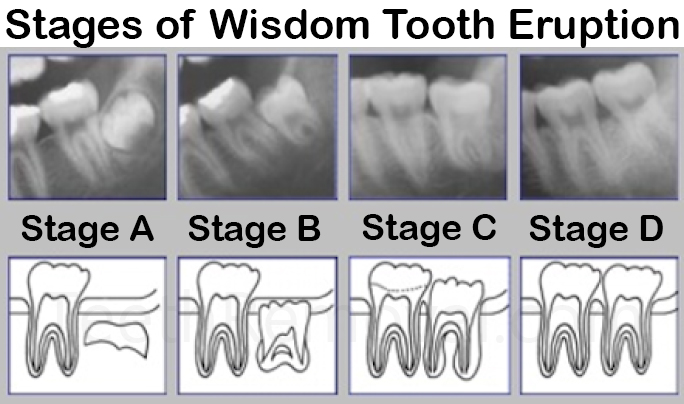
Since stages A and B must be assessed with x-ray, the below will focus on those results presented from the studies. Statistically significant differences were found in females and males of stages A and B between ethnic groups. South African females reached these stages prior to German females and both South African females and German females were younger than when Japanese females reached these stages. South African males reached these stages at younger ages than German males and South African males were younger than when Japanese males reached these stages. The specific studies are 1.) Ozle et al., “Studies of the Chronological Course of Wisdom Tooth Eruption in a Black African Population,” Journal of Forensic Sciences, vol. 52, no. 5, pp. 1161-1163, Sep. 2007, 2.) Ozle et al., “Studies of the chronological course of wisdom tooth eruption in a German population,” Journal of Forensic and Legal Medicine, vol. 15, pp. 426–429, 2008, 3.) Ozle et al., “Studies of the chronological course of wisdom tooth eruption in a Japanese population,” Forensic Science International, vol. 174, pp. 203–206, 2008, 4.) Ozle al., “Comparative study on the effect of ethnicity on wisdom tooth eruption,” International Journal of Legal Medicine, vol. 121, no. 6, pp 445–448, Nov. 2007. Some new visuals from the data from these studies generated by this website’s author are presented below generated using Minitab 18 (where the two upper wisdom teeth are combined into an average and the two lower wisdom teeth are also combined into an average for stages A and B).

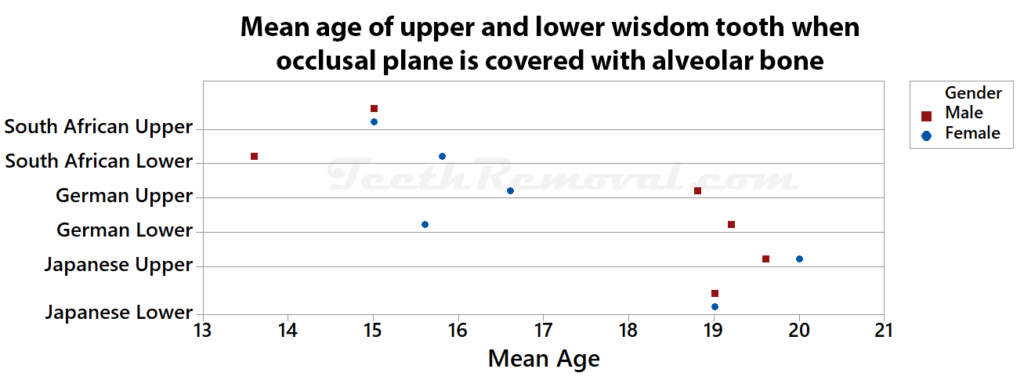

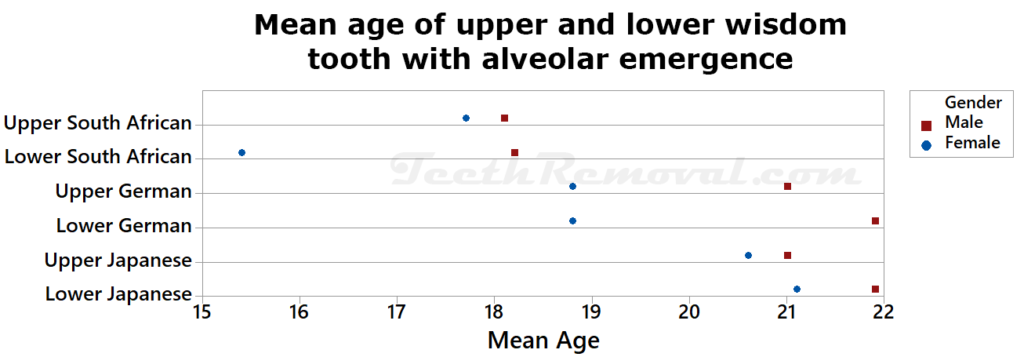
The lead author of the studies by Olze et al. also published another study a few years later that looked at 605 panaramic x-rays in 605 Canadians in a similar manner as the above mentioned studies to look at four different stages of wisdom tooth emergence. This study by Schmeling and Olze et al. is titled “Dental Age Estimation Based on Third Molar Eruption in First Nations People of Canada,” in the Journal of Forensic Odonto-Stomatology (vol. 28, no. 1, pp. 32-38, 2010). According to the article, the Canadians were between South Africans and Germans in most stages and in both sexes when compared to their earlier studies. Some data from this study is combined with the data from the prior studies by Olze et al. to create new visuals that follow. However, due to the different age structure of the Canadian sample compared to the populations in the earlier study of Germans, Japanese and black South Africans any conclusions should be made carefully.
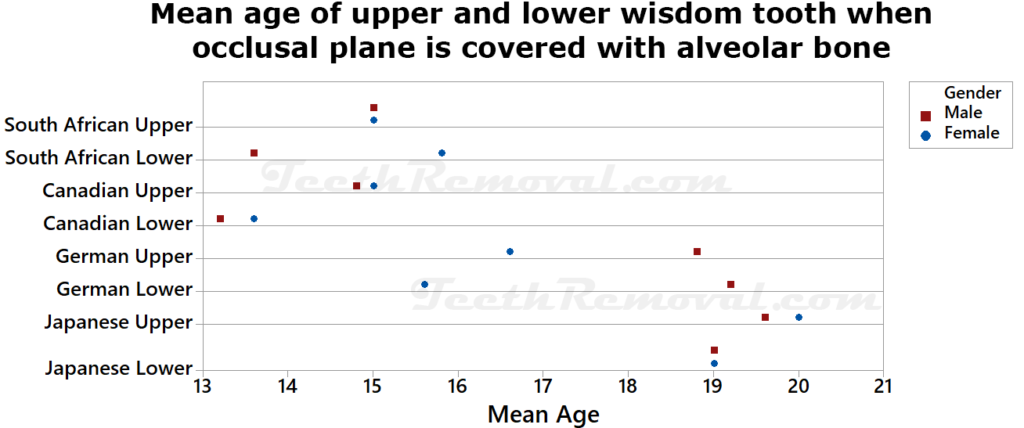
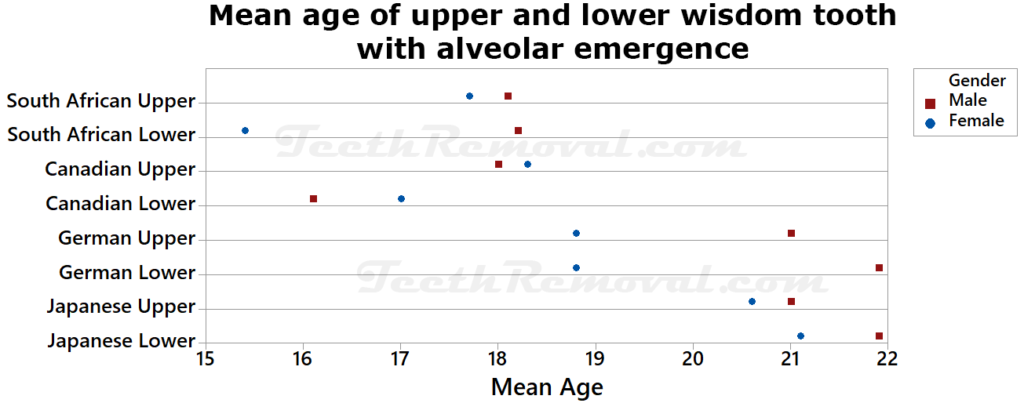
The bottom line from using wisdom teeth to estimate age is that there are clear differences among ethnic groups when looking at wisdom tooth eruption. The figures presented above make it pretty obvious that some ethnic groups have mean age differences from others by several years. The five studies from Olze et al. mentioned above build upon an earlier study by Olze et al. titled “Forensic age estimation in living subjects: the ethnic factor in wisdom tooth mineralization,” in the International Journal of Legal Medicine (no. 118, pp. 170–173, 2004) which suggested the population differences observed from their study is from the differences in palatal dimensions between the ethnic groups. Thus relying on X-rays without understanding ethnic differences may cause errors to be made in age estimation which could lead to further ramifications and consequences for migrants.

5 thoughts on “Forensic Age Estimation using Wisdom Teeth”